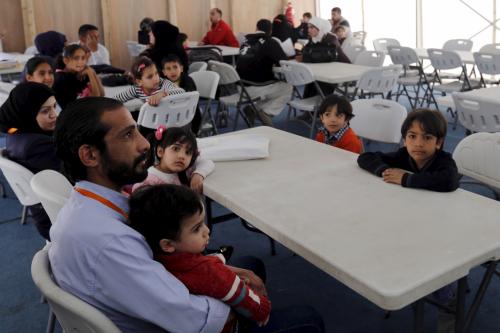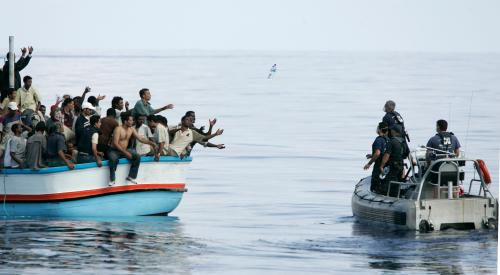November 20th is Universal Children’s Day, the date marking the U.N. General Assembly’s adoption of the Declaration of the Rights of the Child in 1959, and the Convention on the Rights of the Child in 1989. The latter, the most widely ratified international human rights treaty, sets forth children’s right to life, health, education, play, the right to family life, protection from violence, to not be discriminated, and have their views heard. This year, U.N. Secretary-General Bank Ki-moon stressed “especially those suffering the impacts of poverty, armed conflict, discrimination, and exploitation” while emphasizing “the importance of ensuring that the commitments made by the international community to the world’s children are extended to a group of children who are often forgotten or overlooked: those deprived of their liberty.”
Among those most vulnerable are the nearly 50 million children, defined as those under the age of 18, who are refugees or migrants—their numbers have risen 77 percent in the last five years. Uprooted from their homes, 28 million are displaced children, nearly 11 million of them are refugees who have left their countries, a million await asylum, and a further 17 million are internally displaced within their countries. Another 20 million are child migrants who have fled their homes due to extreme poverty, gang violence, or other factors. As noted by UNICEF, all are at “particular risk of abuse and detention because they have no documentation, have uncertain legal status, and there is no systematic tracking and monitoring of their well-being—children falling through the cracks.” Anti-Slavery International notes that aside from sexual exploitation, children are often trafficked into forced labor in agriculture, domestic servitude, as well as criminality and forced begging.
A growing phenomenon is children traveling alone, some who set out unaccompanied as well as those separated from adults, most often parents, they were with. In 2015 well over 100,000 unaccompanied children filed for asylum—a threefold increase over 2014. That year Germany alone took 42,300 unaccompanied children, 91 percent who were boys, into youth protective custody—quadrupling 2014 numbers. UNICEF reported that of the 7,500 children who undertook the journey from Africa—mostly from Libya—to Europe in the first five months of 2016, 92 percent were traveling alone. That number had reached 11,500 by July.
So why are there so many children on the move? Aside from the thousands who were separated from their families on the road, there are many who were sent off by their parents because home is just too dangerous and children are targeted by radical groups or gangs. In 2014, 67,000 unaccompanied minors from Central America were caught at the U.S. border, with the number decreasing to 30,000 in 2015 after Mexico cracked down and the U.S took measures to ensure that all knew that minors would not be exempt from deportation. But with violence increasing, it is not uncommon now for whole families to flee together to safeguard their children. In the year prior to September 2016, 77,000 Central Americans traveling as families were detained trying to cross the U.S. border—up 23 percent from 2015.
In Europe, most of the unaccompanied minors come from Afghanistan, Syria, and Eritrea and enjoy special protection measures compared to adults. In many countries, including Germany, they cannot be readily deported, though services for them are under severe strain. There are also the inevitable “anchor children”—those that are sent to Europe, preferably Germany or Sweden, to gain legal status and allow their families to join them later. Of the nearly 100,000 unaccompanied children seeking asylum in the European Union in 2015, over 50 percent were Afghan boys, half of whom were between 16 and 17 years old. Whatever the circumstances, however, both European Asylum Support Office and a U.K. parliamentary report underline that authorities needed to ensure that “all those under 18 [years old] should be treated as children first and foremost.”
The issue of trafficking and deprivation of liberty remains an area of huge concern, highlighted recently by the 10,000 unaccompanied children reported as missing by Europol. Many may have simply reunited with their families or found safety, but many others are undoubtedly being preyed upon. And while both genders are at risk of trafficking and severe abuse, girls are even more vulnerable.
Europol notes that “an entire criminal infrastructure has developed…around exploiting the migrant flow. There are prisons in Germany and Hungary where the vast majority of people arrested and placed there are in relation to criminal activity surrounding the migrant crisis.” Not surprisingly, these groups have links to people smugglers as well as to older organized criminal groups in Italy and elsewhere. Save the Children reports that girls as young as 13 years old from Nigeria are being forced into prostitution and Egyptian boys are working 12 hours a day, seven days a week, washing cars for 2 euros an hour to pay off debts to traffickers. Harrowing stories from youngsters making it out of Libya to Europe through pay-as-you-go practices tell of the awful conditions they had to work in to pay for portion of their journey—a practice seen in almost all transit countries.
These are difficult issues to confront, but the plight of refugee children, especially the unaccompanied, needs a concerted effort with better coordination between humanitarian, government, security, and development agencies as well as nongovernmental organizations. UNICEF calls for prioritizing their asylum applications, making every effort to reunite children with their families, prevent their detention, especially in adult centers, and the strict application of “non-refoulement” prohibiting deportation to countries where they might face human rights violations or be denied health, education, and protection from trafficking. This is certainly something to reflect upon on Universal Children’s Day.
The Brookings Institution is committed to quality, independence, and impact.
We are supported by a diverse array of funders. In line with our values and policies, each Brookings publication represents the sole views of its author(s).








Commentary
The lone refugee child and Universal Children’s Day
November 15, 2016